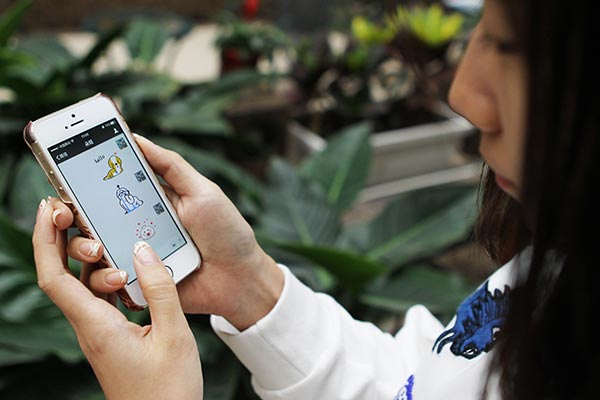 |
|
A young woman communicates with a friend with emoticons on her smartphone in Beijing. GUAN XIN / CHINA DAILY |
In recent years, I've noticed with amazement how emoticons and smiley faces have crept into my office life. Supervisors start the day with them as they issue instructions on social messaging app WeChat. Staff who are mostly in their late 20s and 30s respond with a wild variety of emojis that laugh, weep, blush or swagger. Even the secretary has instilled a personal note in her daily reminder to all for the submission of the next day's work plan, with an icon of a red rose.
At first I'd typed:) or :( to indicate what I felt in my e-mails and messages to colleagues. They worked like arms and hands in a speech that helped me emphasize a point or ensure what I said was not misunderstood. But the colons and parentheses have quickly fallen from favor, with the rise of emojis that best encapsulates the basic communication tenet that a picture is worth a thousand words.
For laughter, users can pick a face with a smile, snicker or giggle and other expressions that are too complex for a simple :) to show. The icons could also render words unnecessary in certain conversations. Last week, netizens watched two pandas mating in southwestern China and bemoaned their performance as they fell behind the record set by another pair last year. We also talked about it on WeChat, which could probably boil down to just a sweating face with raised eyebrows, which was posted by a co-worker at the end of the discussion.
But emojis, especially those pictures with Chinese characters, are not for everybody and most probably not appropriate for business communication.
Chinese emoji users are predominantly young people led by millennials who send the most emojis per day, according to Tencent Holdings Ltd, one of the most popular providers of social media including WeChat in China. In comparison, users aged 40 or older account for only a small fraction of emoji fans and they sent an emoji every three days.
Tencent found that in 2014, the top five most-used emojis were a wicked smile, anger, kissing, head beating and melancholy. Emojis favored by men tend to be nerdy and dorky while women prefer "cutesy" icons.
It's a trend that domestic emoji developers have noted and marketed as they focus on products that are vivid, exaggerated and reflect the ethos of youthful, restless and hormonal internet users.
Older users who want to be "on trend" may sometimes find they're courting embarrassment. Once I sent a new emoji with Chinese characters "I'm panicky" when we discussed a project that could fail, one of the colleagues quickly pointed out, " Even you're using it!"
And often, people disagree on what certain emojis were supposed to represent. When writing this article, I've checked with several colleagues on the meanings of some emoji stored in our cellphones, and we were surprised to realize how our understanding could differ from each other and from the emoji's actual intent.
The importance of knowing what it means hit home last Friday morning, when I sent what I assumed as a sign of prayer to a working mom who was applying for leave because her son was sick. She texted back: "The emoji technically represents a high-five, although we commonly take it as hands clasped in prayer."
